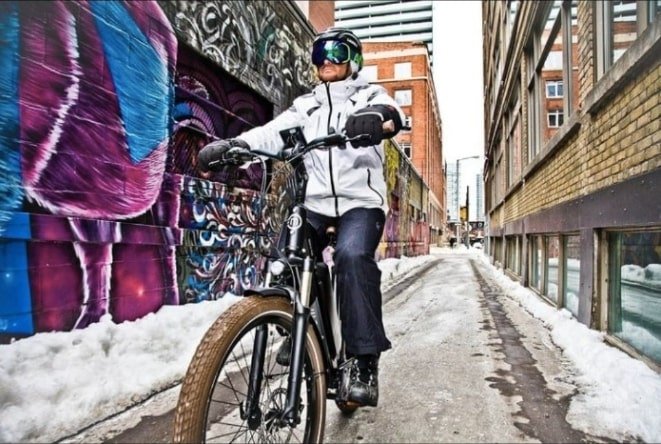Winter Riding: Ebike Edition
Here’s what you need to know about riding an ebike in the winter:
From keeping your battery protected from the elements to keeping your body protected from the cold, let’s get into everything you need to know to keep riding your ebike through the winter
Battery Best Practices:
As you may already know, extreme temperatures are bad for batteries. This is why your phone shuts itself off if you leave it out in direct sunlight at the beach or if you drop it in the snow while you’re sledding. This holds true for your ebike battery too. Be careful when temperatures reach -5°F as that’s when batteries can lose functionality and be sure to recharge your battery at room temperature – batteries cannot charge below 32°F.
Most ebikes will have proper waterproof casing around the battery and other electronic bits so you shouldn’t have to worry too much about riding through puddles, but make sure you check periodically for frayed wires to make sure there’s no exposed electronics and wipe off excess snow & salt after a ride.
Bundling Best Practices:
When using full power on an ebike, your body isn’t working as hard – that’s the whole point! However, in the winter this can be a bit of a disadvantage. Because you’re not working as hard, you’re not generating as much of your own heat that could be trapped to keep you warm, so you need to bundle accordingly.
Make sure you wear lots of layers instead of one big coat; not only will you be able to regulate your temperature better by shedding layers, but the air trapped between layers will act as extra insulation against the cold. Also, keep in mind that the parts of your body furthest from your core (hands, feet, and face) will also get the most exposure to the wind, making them the most difficult to keep warm. So make sure you have some high quality gloves, socks, and a buff to keep that cold out.
Don’t forget to prioritize your visibility! Drivers will not expect people to be riding bikes in rough conditions so it’s doubly important to wear a reflective layer in the cold. And don’t forget to also kit out your ebike with some flashing lights to make sure you stand out in traffic.
Handling Best Practices:
Everything you’d do to control an analog bike in wet conditions also applies to ebikes, but doubly so since an ebike can be more than double the weight. If you’ve never ridden in snow before (or if you have and you want a refresher), it can be a good idea to find an empty parking lot after a fresh dusting of snow to practice how it feels to ride in slick conditions. Start out by getting a feel for how your ebike handles by doing a test ride without the motor on. Once you have the hang of that, gradually increase the power to get a sense of how the extra boost affects the handling.
Here are my top 3 handling tips when riding on snowy, wet & icy roads:
Start Slow! Don’t dive in all at once when temperatures dip below freezing; it’s way easier to ease yourself into cold weather riding when you simply adjust your summer riding routine as the weather slowly changes.
Go slow!! The roads are going to be a bit like a slip n’ slide for a couple days after a big snow or rainfall. Go around corners slowly. Stop earlier than you need. Proceed with extra caution and plan for your commute to take extra time in the winter.
Have Fun:) Riding your bike is one of the simplest joys there is, don’t let a bad experience in the cold ruin it for you. If you’re having a hard time getting through the snow or getting out of bed when you know you have to ride in the cold, there’s no shame in leaving your bike in the garage. Start small & stop when it’s not fun anymore, your bike will be waiting for you when everything thaws.




